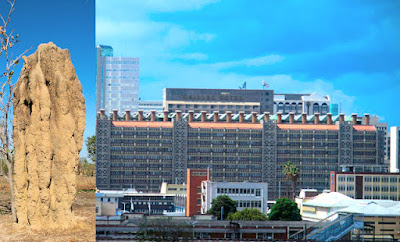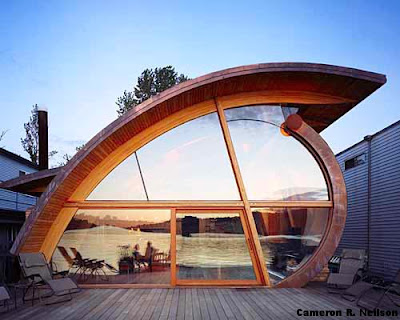Eastgate Centre in Zimbabwe : Modeled After Termite Mounds
 Designed by the architect Mick Pearce in conjunction with engineers at Arup Associates, Eastgate Building in Harare, Zimbabwe, is just one example of sustainable architecture that uses dramatically less energy by copying the successful strategies of indigenous natural systems. The building - the country's largest commercial and shopping complex - uses the same heating and cooling principles as a local termite mound.
Designed by the architect Mick Pearce in conjunction with engineers at Arup Associates, Eastgate Building in Harare, Zimbabwe, is just one example of sustainable architecture that uses dramatically less energy by copying the successful strategies of indigenous natural systems. The building - the country's largest commercial and shopping complex - uses the same heating and cooling principles as a local termite mound.That's no mean feat. Termite mounds are marvels of engineering. Deep inside, the insects farm a fungus, their only food. It must be kept at exactly 87 degrees, while the temperatures on the African veld outside range from 35 degrees at night to 104 degrees during the day.
They do it by venting breezes in at the base of the mound, down into chambers cooled by wet mud carried up from water tables far below, and up through a flue to the peak. Toiling with the tireless, compulsive work ethic of all ants, they constantly dig new vents and plug old ones to regulate the temperature.
Temperature regulation is a struggle familiar to any architect. Mick Pearce of the Pearce Partnership was given a challenge by Old Mutual, an insurance and real estate conglomerate: build an office block that would be livable with no air-conditioning and almost no heating.

This is a terrific example of sustainable architecture that is biomimetic, indigenous, and economically viable on its face. Yet the Eastgate story also demonstrates an important aspect of the sustainability/biomimicry trend - that incrementally greater value may be found by studying solutions from those niches (ecological and economic) where resources are more constrained than the ones you inhabit. Don't study the oasis - study the desert.
Termite Mounds Inspire Design of Zimbabwe Office Complex.
The complex is actually two buildings linked by bridges across a shady, glass-roofed atrium open to the breezes.
To keep the harsh highveld sun from heating the interior, no more than 25 percent of the outside is glass, and all the windows are screened by an unusual form of sunshade: racks of cement arches that jut out more than a yard.
Fans suck fresh air in from the atrium, blow it upstairs through hollow spaces under the floors and from there into each office through baseboard vents. As it rises and warms, it is drawn out through ceiling vents. Finally, it exits through 48 round brick chimneys.

During summer's cool nights, big fans flush air through the building seven times an hour to chill the hollow floors. By day, smaller fans blow two changes of air an hour through the building, taking advantage of what Pearce calls "the coolth in the slab." For winter days, there are small heaters in the vents.
- The Eastgate's owners saved $3.5 million on a $36 million building because an air-conditioning plant didn't have to be imported
- The building uses less than 10 percent of the energy of a conventional building its size.


Comments